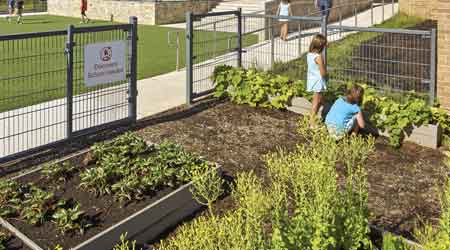 The Discovery School Garden provides experiential learning opportunities for students about urban farming, environmental stewardship, and sustainability.Alan Karchmer Photography
The Discovery School Garden provides experiential learning opportunities for students about urban farming, environmental stewardship, and sustainability.Alan Karchmer Photography How Sustainable Buildings Aid Experiential Learning in Schools
Sustainability is embedded in the culture of Arlington Public Schools, and that translates to both better buildings and a richer classroom experience.
While it’s the big-splash projects, like the net-zero energy Discovery Elementary School that get the headlines, Chadwick says he’s working hard to embed sustainability into the culture of the entire school district. A district-wide embrace of green is the way to reach those big net-zero stretch goals — to ensure that everyone is pushing the same way, that sustainability is prized by everyone from first graders to principals.
To that end, APS has created a Sustainability Liaison Program. Starting with 10 schools two years ago, and now expanded to 15 schools, a sustainability liaison — a teacher who receives a stipend of about $1,000 for his or her efforts — works with students and facilities staff to implement lessons about sustainability in the classroom. Lin, who manages the program, says that it’s been fun to see creativity in the programs developed. “The teachers have really embraced this idea of project-based learning,” she says.
As one example, a school developed a program to offer free tune-ups for bicycles to encourage biking to school. Another provided incentives to encourage walking to school. These are important, says Chadwick, because a priority for APS is to reduce its transportation footprint.
Other schools have begun gardening clubs, donated food to local pantries, and improved recycling programs. Discovery held a screening of the movie, A Plastic Ocean, says Russo, and then did a Skype session with the filmmakers and scientists who made the movie. The school then pledged to reduce single-use plastics and raised money for the film’s charity.
A goal of the Sustainability Liaison Program is to create experiential learning opportunities, to bring sustainability to the classroom in vivid, hands-on ways. And in many cases, it’s the buildings themselves that provide these opportunities. At Discovery, for instance, an energy dashboard shows how much electricity the solar panels on the roof are producing, how much the school is currently using, and whether there’s a surplus or shortfall. Chadwick says one of his long-term goals is to put similar dashboards in every school. Right now, annual energy data is posted on APS’s website, but “our goal is to have an overall system where every kid has access to this data,” says Chadwick. That system, he says, may be part of the upcoming performance contracting APS is currently researching. “We want the energy dashboard at each school to be an integral part of the classroom,” he says. These dashboards, specifically, but all the opportunities for hands-on learning about sustainability generally, connect students to nature and helps them really understand their place in the world, says Russo. “I’ve always believed that teaching and learning should be hands-on and authentic,” she says. “But now, with our building, I see it, and this building emphasizes the power of it.”
After all, says Chadwick, “Facilities are a means to an end, rather than an end in and of themselves. We’re here for the success of our students.”
Email comments and questions to greg.zimmerman@tradepress.com.
Related Topics:













